Best Famous Basque Food | All About Basque Cuisine

- By
- Aparna Patel
- |
- 19 Apr, 2023
- |

Welcome to our blog on the Best Famous Basque Food! Basque cuisine is a unique and vibrant culinary tradition that originates from the Basque Country, an autonomous region in Spain and France. It is renowned for its bold flavors, fresh ingredients, and rich cultural heritage.
In this blog, we will explore everything you need to know about Basque cuisine, including its history, signature dishes, and local specialties. From pintxos to seafood stews, Basque cuisine is sure to delight your taste buds and satisfy your curiosity about this fascinating culinary tradition. So join us as we delve into the world of Basque food and discover the Best Famous Basque Food!
Table of Contents
Famous Basque Dishes
Basque cuisine is known for its unique flavors and techniques that have been developed over centuries in the Basque Country, an autonomous community located in northern Spain and southwestern France. Here are 10 famous Basque dishes:
- Pintxos: Small bite-sized snacks that are typically served on bread and skewered with a toothpick.Pintxos are a beloved Basque culinary tradition, similar to the Spanish tapas or the Italian antipasti. These bite-sized snacks or small plates are typically served on a slice of bread and are meant to be enjoyed with a drink or as a quick snack.Pintxos can feature a variety of ingredients, from meats and cheeses to vegetables and seafood. Some popular pintxos include skewered marinated anchovies, chorizo with quail egg, grilled mushrooms with garlic and parsley, and roasted red peppers with goat cheese. Each pintxo is typically held together with a toothpick or skewer, making them easy to eat on the go.
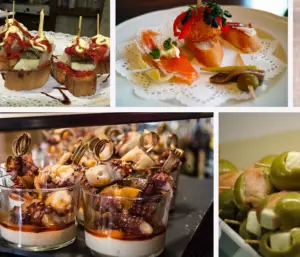 One of the great things about pintxos is that they are often displayed on the bar or counter of a restaurant, allowing customers to choose the ones they want and try a variety of flavors. It is a social and communal way of dining, where people can share and enjoy different pintxos together.Pintxos are a testament to the Basque region’s love of bold flavors, fresh ingredients, and communal dining. They are a must-try for anyone visiting the Basque Country and are a delicious example of the region’s rich culinary traditions.
One of the great things about pintxos is that they are often displayed on the bar or counter of a restaurant, allowing customers to choose the ones they want and try a variety of flavors. It is a social and communal way of dining, where people can share and enjoy different pintxos together.Pintxos are a testament to the Basque region’s love of bold flavors, fresh ingredients, and communal dining. They are a must-try for anyone visiting the Basque Country and are a delicious example of the region’s rich culinary traditions. - Bacalao al Pil Pil: A dish made with salted cod, garlic, and olive oil, often served with potatoes.Bacalao al Pil Pil is a traditional Basque dish that features salt cod cooked in a sauce made from olive oil, garlic, and chili peppers. The dish is named after the sound that the sauce makes as it emulsifies during cooking – “pil-pil-pil-pil.”To prepare the dish, the salt cod is first soaked to remove excess salt and then seared in a hot pan until it is lightly browned. The garlic and chili peppers are then sautéed in olive oil until fragrant, and the pan is deglazed with a little water or white wine. The seared salt cod is then added back into the pan, and the sauce is emulsified by swirling the pan and adding more olive oil until a thick, creamy sauce forms.
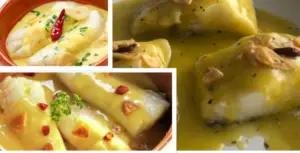 Bacalao al Pil Pil is known for its rich, flavorful sauce that is both spicy and garlicky. The dish is typically served hot with a side of crusty bread for soaking up the delicious sauce. It is a popular dish throughout the Basque Country and is often enjoyed as a main course for lunch or dinner.The dish is a testament to the Basque region’s love of bold, flavorful cuisine and its commitment to using high-quality, locally-sourced ingredients. It is a must-try for anyone visiting the Basque Country and is a delicious example of the region’s rich culinary traditions.
Bacalao al Pil Pil is known for its rich, flavorful sauce that is both spicy and garlicky. The dish is typically served hot with a side of crusty bread for soaking up the delicious sauce. It is a popular dish throughout the Basque Country and is often enjoyed as a main course for lunch or dinner.The dish is a testament to the Basque region’s love of bold, flavorful cuisine and its commitment to using high-quality, locally-sourced ingredients. It is a must-try for anyone visiting the Basque Country and is a delicious example of the region’s rich culinary traditions. - Marmitako: A hearty fish stew made with tuna, potatoes, peppers, and onions.Marmitako is a traditional Basque fish stew that is typically made with fresh tuna, potatoes, onions, peppers, and tomatoes. The dish is named after the Basque word “marmita,” which means pot or cauldron, and “ako,” which means “of.”To prepare marmitako, the fish is typically seared in a hot pan and then set aside. The onions and peppers are then sautéed in the same pan with garlic and tomatoes until they are soft and fragrant. The seared tuna is then added back into the pot along with potatoes and a fish or vegetable broth. The stew is then simmered until the potatoes are tender and the flavors have melded together.
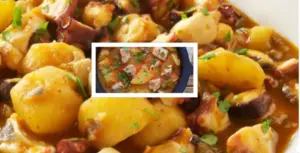 Marmitako is known for its rich, hearty flavor and its comforting, warming nature. It is a popular dish throughout the Basque Country and is often served as a main course for lunch or dinner. The dish is typically enjoyed with a glass of local Basque cider or wine.While marmitako may seem like a simple dish, it is a testament to the Basque region’s commitment to using fresh, high-quality ingredients and to the art of slow-cooked cuisine. It is a must-try for anyone visiting the Basque Country and is a delicious example of the region’s rich culinary traditions.
Marmitako is known for its rich, hearty flavor and its comforting, warming nature. It is a popular dish throughout the Basque Country and is often served as a main course for lunch or dinner. The dish is typically enjoyed with a glass of local Basque cider or wine.While marmitako may seem like a simple dish, it is a testament to the Basque region’s commitment to using fresh, high-quality ingredients and to the art of slow-cooked cuisine. It is a must-try for anyone visiting the Basque Country and is a delicious example of the region’s rich culinary traditions. - Txangurro: A dish made with spider crab meat, onion, tomato, and white wine, often served in the crab shell.Txangurro is a traditional Basque dish that is made from spider crab meat that is typically found along the northern coast of Spain. The dish is a rich and flavorful crab gratin that is often served as an appetizer or as a main course.To prepare txangurro, the spider crab meat is mixed with a mixture of onion, tomato, garlic, and herbs, and then blended with a creamy béchamel sauce.
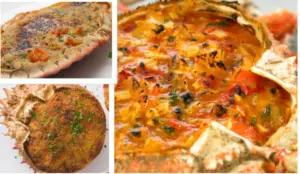 The mixture is then stuffed back into the crab’s shell, topped with breadcrumbs and grated cheese, and baked in the oven until the top is golden brown and crispy.The dish is known for its rich, savory flavor and its creamy, indulgent texture. It is often served with a slice of crusty bread or alongside a fresh salad or vegetable side dish. The dish is a beloved example of the Basque region’s rich culinary heritage and is a must-try for anyone visiting the region.Today, txangurro can be found in many restaurants throughout the Basque Country and beyond. While the dish may seem indulgent and complex, it is a testament to the region’s commitment to using fresh, high-quality ingredients and to the art of traditional, slow-cooked cuisine.
The mixture is then stuffed back into the crab’s shell, topped with breadcrumbs and grated cheese, and baked in the oven until the top is golden brown and crispy.The dish is known for its rich, savory flavor and its creamy, indulgent texture. It is often served with a slice of crusty bread or alongside a fresh salad or vegetable side dish. The dish is a beloved example of the Basque region’s rich culinary heritage and is a must-try for anyone visiting the region.Today, txangurro can be found in many restaurants throughout the Basque Country and beyond. While the dish may seem indulgent and complex, it is a testament to the region’s commitment to using fresh, high-quality ingredients and to the art of traditional, slow-cooked cuisine. - Idiazabal Cheese: A hard cheese made from sheep’s milk that is often served with quince paste.Idiazabal cheese is a traditional, artisanal cheese that originates from the Basque Country and Navarre regions of Spain. It is a semi-hard, raw sheep’s milk cheese that has been produced in the area for centuries and is named after the small village of Idiazabal in the province of Gipuzkoa.
 The cheese has a distinctive flavor that is both rich and tangy, with hints of nuttiness and smokiness that come from the traditional smoking process. The cheese is typically aged for several months, during which time it develops a hard, natural rind and a firm, dense texture.Idiazabal cheese is made using only the milk of Latxa or Carranza sheep, two native breeds that are known for their rich and flavorful milk. The cheese is produced using traditional methods, including hand-milking, slow-cooking the curd, and smoking the cheese over beechwood logs.The cheese is a beloved ingredient in Basque cuisine and is often served alongside traditional dishes such as chuletón (thick ribeye steak), pintxos (small tapas-style snacks), and salads. It is also commonly paired with local wines such as Rioja or Txakoli.
The cheese has a distinctive flavor that is both rich and tangy, with hints of nuttiness and smokiness that come from the traditional smoking process. The cheese is typically aged for several months, during which time it develops a hard, natural rind and a firm, dense texture.Idiazabal cheese is made using only the milk of Latxa or Carranza sheep, two native breeds that are known for their rich and flavorful milk. The cheese is produced using traditional methods, including hand-milking, slow-cooking the curd, and smoking the cheese over beechwood logs.The cheese is a beloved ingredient in Basque cuisine and is often served alongside traditional dishes such as chuletón (thick ribeye steak), pintxos (small tapas-style snacks), and salads. It is also commonly paired with local wines such as Rioja or Txakoli.
Today, Idiazabal cheese is recognized as one of the most iconic and delicious cheeses of Spain, and is enjoyed by cheese lovers around the world. It is a delicious example of the rich culinary traditions found in the Basque Country and a testament to the region’s commitment to high-quality, artisanal food production.
- Chuleta: A grilled beef rib chop that is often served with roasted vegetables.Chuleta, also known as Txuleta, is a traditional dish from the Basque Country in Spain. It is a thick-cut ribeye steak that is typically cooked over an open flame or charcoal grill, seasoned simply with coarse sea salt.
 The chuleta is a signature dish of Basque cuisine and is highly regarded for its rich, beefy flavor and tender, juicy texture. The quality of the meat is of utmost importance, and many restaurants in the Basque Country source their chuletas from local farms that raise high-quality beef cattle.The chuleta is often served with traditional Basque accompaniments, such as piquillo peppers, blistered padrón peppers, and a side of crispy fried potatoes known as patatas bravas. It is also commonly paired with a full-bodied red wine, such as a Rioja or a Tempranillo.While the chuleta may seem like a simple dish, it is a testament to the Basque culture’s reverence for high-quality ingredients and the art of open-fire cooking. It is a must-try dish for any meat lover visiting the Basque Country, and a delicious example of the region’s rich culinary traditions.
The chuleta is a signature dish of Basque cuisine and is highly regarded for its rich, beefy flavor and tender, juicy texture. The quality of the meat is of utmost importance, and many restaurants in the Basque Country source their chuletas from local farms that raise high-quality beef cattle.The chuleta is often served with traditional Basque accompaniments, such as piquillo peppers, blistered padrón peppers, and a side of crispy fried potatoes known as patatas bravas. It is also commonly paired with a full-bodied red wine, such as a Rioja or a Tempranillo.While the chuleta may seem like a simple dish, it is a testament to the Basque culture’s reverence for high-quality ingredients and the art of open-fire cooking. It is a must-try dish for any meat lover visiting the Basque Country, and a delicious example of the region’s rich culinary traditions. - Tarta de Santiago: A traditional almond cake that is typically served for special occasions.Tarta de Santiago, also known as St. James Cake, is a traditional dessert that originates from the Galicia region of Spain. It is a simple and rustic cake that is made from ground almonds, eggs, sugar, and lemon zest, and is traditionally decorated with a dusting of powdered sugar in the shape of the cross of St. James.The cake has a dense, moist texture and a rich, nutty flavor that comes from the ground almonds.
 It is often served as a dessert during festivals and celebrations in Galicia, and is especially popular during the annual pilgrimage to Santiago de Compostela, a city in Galicia that is the endpoint of the famous Camino de Santiago pilgrimage route.Legend has it that Tarta de Santiago was created by a local baker who wanted to create a special cake to welcome pilgrims who had completed the Camino de Santiago. The cake was named after St. James, the patron saint of Spain, whose remains are said to be buried in Santiago de Compostela.Today, Tarta de Santiago is a beloved dessert throughout Spain and beyond, and can be found in many bakeries and restaurants around the world. Its simple yet distinctive flavor and appearance make it a popular choice for both casual and formal occasions, and a delicious example of the rich culinary traditions found in different regions of Spain.
It is often served as a dessert during festivals and celebrations in Galicia, and is especially popular during the annual pilgrimage to Santiago de Compostela, a city in Galicia that is the endpoint of the famous Camino de Santiago pilgrimage route.Legend has it that Tarta de Santiago was created by a local baker who wanted to create a special cake to welcome pilgrims who had completed the Camino de Santiago. The cake was named after St. James, the patron saint of Spain, whose remains are said to be buried in Santiago de Compostela.Today, Tarta de Santiago is a beloved dessert throughout Spain and beyond, and can be found in many bakeries and restaurants around the world. Its simple yet distinctive flavor and appearance make it a popular choice for both casual and formal occasions, and a delicious example of the rich culinary traditions found in different regions of Spain. - Basque Cake: A dense, buttery cake made with almonds and orange zest.Basque cake, also known as Gâteau Basque, is a traditional dessert that hails from the Basque Country, an autonomous region that straddles the border between France and Spain. It is a buttery, tender cake that is typically filled with either a vanilla pastry cream or a thick layer of cherry jam.
 The cake itself is made from a simple mixture of flour, sugar, eggs, and butter, and is flavored with a hint of almond extract or lemon zest. It is often baked in a circular tart pan with a scalloped edge, which gives it its distinctive shape and appearance.While the exact origin of Basque cake is unclear, it is believed to have been inspired by the French gateau breton, a similar buttery cake from the Brittany region of France. Over time, the Basque version of the cake evolved to include local flavors and ingredients, such as the cherry jam that is commonly used as a filling.Today, Basque cake is a beloved dessert throughout the Basque region and beyond, and can be found in many bakeries and restaurants around the world. Its rich, buttery flavor and simple yet elegant appearance make it a perfect dessert for any occasion, from casual family gatherings to formal dinner parties.
The cake itself is made from a simple mixture of flour, sugar, eggs, and butter, and is flavored with a hint of almond extract or lemon zest. It is often baked in a circular tart pan with a scalloped edge, which gives it its distinctive shape and appearance.While the exact origin of Basque cake is unclear, it is believed to have been inspired by the French gateau breton, a similar buttery cake from the Brittany region of France. Over time, the Basque version of the cake evolved to include local flavors and ingredients, such as the cherry jam that is commonly used as a filling.Today, Basque cake is a beloved dessert throughout the Basque region and beyond, and can be found in many bakeries and restaurants around the world. Its rich, buttery flavor and simple yet elegant appearance make it a perfect dessert for any occasion, from casual family gatherings to formal dinner parties. - Kalimotxo: A drink made with red wine and Coca-Cola that is popular in the Basque Country.A popular drink that originated in the Basque region of Spain. It is made by mixing equal parts of red wine and cola and is typically served over ice.While Kalimotxo is not a food, it is often enjoyed alongside traditional Basque dishes, such as pintxos (small tapas-style snacks), seafood stews, and grilled meats.
 The drink is especially popular during festivals and outdoor gatherings, where it is often served in large pitchers or dispensed from kegs.Although it may sound like an unusual combination, Kalimotxo has a surprisingly refreshing and balanced flavor that has made it a beloved drink in many parts of Spain and beyond. It is a testament to the Basque culture’s creative and playful approach to food and drink, and a reminder that culinary traditions can be both delicious and delightfully unexpected.
The drink is especially popular during festivals and outdoor gatherings, where it is often served in large pitchers or dispensed from kegs.Although it may sound like an unusual combination, Kalimotxo has a surprisingly refreshing and balanced flavor that has made it a beloved drink in many parts of Spain and beyond. It is a testament to the Basque culture’s creative and playful approach to food and drink, and a reminder that culinary traditions can be both delicious and delightfully unexpected. - Percebes:Percebes, also known as gooseneck barnacles, are a type of seafood that is highly prized for their unique taste and texture. These crustaceans grow on rocks in the intertidal zone along the coastlines of the Atlantic Ocean, particularly in the Galicia region of Spain and Portugal.Percebes are a delicacy that require skilled harvesting, as they are found in difficult-to-reach areas and must be collected by hand.
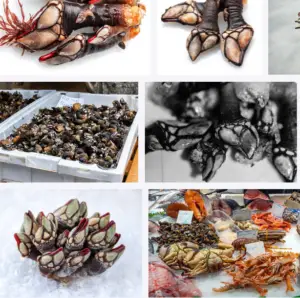 They have a long, slender, and curved shape that resembles a goose’s neck, hence their common name. Percebes have a tough outer shell that must be removed before eating, and the tender meat inside has a briny, slightly sweet flavor.Due to the challenging and dangerous process of harvesting percebes, they are considered a luxury food item and can be quite expensive. In some regions, they are considered a traditional dish and are often served at special occasions and celebrations.While percebes are not widely known outside of coastal regions, they are a prized delicacy for seafood lovers and a fascinating example of the unique and diverse culinary traditions found in different parts of the world.
They have a long, slender, and curved shape that resembles a goose’s neck, hence their common name. Percebes have a tough outer shell that must be removed before eating, and the tender meat inside has a briny, slightly sweet flavor.Due to the challenging and dangerous process of harvesting percebes, they are considered a luxury food item and can be quite expensive. In some regions, they are considered a traditional dish and are often served at special occasions and celebrations.While percebes are not widely known outside of coastal regions, they are a prized delicacy for seafood lovers and a fascinating example of the unique and diverse culinary traditions found in different parts of the world.
History Of Basque Food
Basque cuisine is known for its unique flavors and ingredients, and has a rich and varied history that spans centuries. The Basque Country is located in the northern part of Spain and the southwestern part of France, and is known for its rugged coastline, fertile valleys, and mountainous terrain. The region’s geography and climate have played a significant role in shaping its cuisine, which is characterized by fresh, locally sourced ingredients and hearty, flavorful dishes.
The Basques have a long history of fishing, farming, and hunting, and many of their traditional dishes are based on these activities. Fish and seafood are staples of the Basque diet, and the region’s coastline provides an abundant supply of fresh seafood such as cod, hake, and sea bass. Inland, the Basques raise sheep and cattle, which provide meat and dairy products like cheese and butter. The Basques are also known for their love of game, including wild boar, rabbit, and quail.
One of the most famous dishes in Basque cuisine is pintxos, which are small, bite-sized snacks that are often served in bars and taverns. Pintxos can be made with a wide variety of ingredients, including seafood, meats, vegetables, and cheeses, and are often served on top of a slice of bread or a skewer.
Another popular Basque dish is bacalao al pil-pil, which is made with salted cod, olive oil, garlic, and chili peppers. The dish is cooked slowly over low heat, allowing the flavors to blend together and creating a rich, creamy sauce.
Other traditional Basque dishes include marmitako, a hearty fish stew made with potatoes and peppers; talo, a type of cornbread that is often served with chorizo or cheese; and txangurro, a crab dish that is often served as a starter or a main course.
In recent years, Basque cuisine has gained international recognition and has become increasingly popular among food lovers around the world. The region is home to a number of Michelin-starred restaurants, and Basque chefs are known for their innovative techniques and creative use of local ingredients. Today, Basque cuisine continues to evolve and grow, while remaining true to its rich culinary heritage.
Basque Food Dessert
Basque cuisine has a rich tradition of desserts, with many delicious options to choose from. Here are some popular Basque desserts:
- Gâteau Basque – This is a traditional Basque cake that features a buttery crust filled with a rich pastry cream or jam. It is often served as a dessert or with coffee for an afternoon snack.

- Pantxineta – This is another Basque pastry that features puff pastry filled with a sweet almond cream. It is often served for special occasions, such as weddings and holidays.

- Intxaursaltsa – This is a traditional Basque dessert that features walnuts cooked in a syrup made from honey and orange peel. It is typically served cold and is a perfect dessert for a hot summer day.
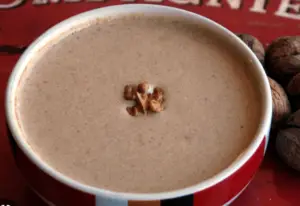
- Idiazabal Cheese with Quince Paste – This is a simple but delicious dessert that features slices of Idiazabal cheese served with a dollop of quince paste. The combination of the salty cheese and the sweet paste is a perfect balance of flavors.
- Torrijas – This is a Basque version of French toast that is typically served during Easter. It features slices of bread soaked in milk, sugar, and cinnamon, and then fried until golden brown.

These are just a few of the delicious desserts that are part of Basque cuisine. They are a perfect way to end a meal or to enjoy as an afternoon snack with a cup of coffee or tea.
Related Post
Traditional Basque breakfast
A traditional Basque breakfast typically consists of simple, wholesome ingredients that are locally sourced and easy to prepare. Here are some examples of what a typical Basque breakfast might include:
- Bread: Basque bread, or “pan de pueblo,” is a staple of the local diet and is often served at breakfast. The bread is usually made with flour, salt, and water, and has a rustic, hearty flavor.

- Jamón: Ham, or “jamón,” is a popular breakfast food in the Basque Country. The ham is typically thinly sliced and served with bread or as part of a sandwich.
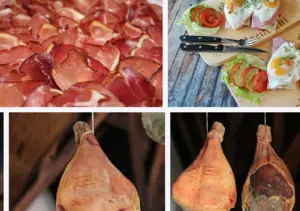
- Cheese: Basque cheese, such as Idiazabal or Roncal, is also a common breakfast food. The cheese is often served with bread or as part of a sandwich.

- Coffee or tea: Coffee, or “café,” is a popular morning beverage in the Basque Country. Tea, or “té,” is also available and is typically served with milk.
- Freshly squeezed orange juice: Freshly squeezed orange juice, or “zumo de naranja,” is a refreshing and healthy way to start the day.

- Basque-style scrambled eggs: A popular Basque breakfast dish is scrambled eggs, or “huevos revueltos,” made with peppers, onions, and sometimes chorizo.

- Pastries: Basque pastries, such as croissants or pain au chocolat, are also available and are often enjoyed with coffee or tea.

Whether you prefer a simple meal of bread and cheese or a more elaborate breakfast dish, there is something for everyone in Basque cuisine.
More Post
Basque Vegetarian Food
Basque cuisine is traditionally quite meat-centric, but there are still plenty of delicious vegetarian options available for those who prefer plant-based meals. Here are some examples of vegetarian dishes that you can find in the Basque Country:
- Pintxos: Many pintxos bars offer vegetarian options, such as pintxos made with grilled vegetables, cheese, or mushrooms.
- Goxua: This traditional Basque dessert is vegetarian and consists of sponge cake, cream, and caramel sauce.
- Vegetable stew: Vegetable stews, or “menestras,” are a popular Basque dish and can be made with a variety of seasonal vegetables.
- Talo: This traditional Basque cornbread can be filled with a variety of vegetarian toppings, such as cheese, tomato, and roasted peppers.
- Gazpacho: This cold soup is made with tomatoes, cucumbers, peppers, and bread and is a refreshing vegetarian option during the summer months.
- Basque cheese: Basque cheese, such as Idiazabal or Roncal, is a delicious vegetarian option and can be enjoyed on its own or with bread.
- Patatas bravas: This classic Spanish dish can be found in many Basque pintxos bars and consists of fried potatoes with a spicy tomato sauce.
These are just a few examples of the many vegetarian dishes that are available in the Basque Country. With its emphasis on fresh, local ingredients, Basque cuisine is sure to have something to offer vegetarians and meat-eaters alike.
Search Posts
Latest posts
-
4 Mar, 2024
Why would you wrap your luggage in plastic?
Popular posts
-
5 Mar, 2024
Why prohibit engine braking?